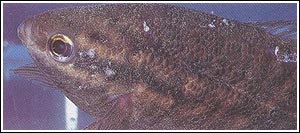Oodinium Parasite, Velvet
This parasite is a microscopic dinoflagellate (two little “whip like organs” or flagella used to propel the parasite through the water). It attaches to the skin (then loses the flagella) of fish in order to feed. Initially it appears as small white dots (similar to ich) but is much finer giving it a “velvet” appearance. They can live without a fish host for up to 24 hours in the water. After establishing on the skin it causes the skin to break open (note the pieces of hanging skin in the picture). This allows secondary bacterial infections or fungal infection. It can cause death in a fish if left untreated.
Treatment
- Recommended treatment. High heat at 93 degrees F. for 3 days (Untergasser,1989)
- Copper sulfate based antiparasitics may be used
- Salt in the aquarium at 1 to 2 tablespoons may help prevent secondary infections
- Clean water. Water changes increase health of discus and eliminate parasites from water.
Source
- Handbook of Fish Diseases by Dieter Untergasser, TFH Publications, Inc 1989
- http://www.ageofaquarium.com/diseases.asp?name=Velvet
In this article symptoms include scratching, rapid breathing, and small white dots. Treatment is with a copper based antiparasitic. - http://www.aquariahobbyist.com/disease/velvet.html
In this article velvet is called a dinoflagellate (has two flagyl), and it also contains chlorophyll. The disease has a free swimming stage of the parasite. It is controlled with copper sulfate. - http://www.petswarehouse.com/Fishmed5.htm
In this article it explains the life cycle of the organism. After 3 to 7 days on the fish, they fall off and into the substrate, where they can remain without a host for up to 3 days. Here they multiply into up to 200 spores. It is untreatable on the fish, only treatable in the free-swimming stage with salt, acriflavine, or malachite/formalin. High temps also kill the parasite but this author feels it will not affect a “cure.” - http://www.noahspets.com/pdisease.html
Here treatments are acriflavine, malachite green , or copper sulfate. - http://www.aquarium.net/0597/0597_4.shtml
This article is fairly detailed including microscopic photos. Treatments include heat, quinine hydrochloride, copper sulfate, or acriflavine. - http://freshaquarium.about.com/library/weekly/aa021002a.htm
In this article symptoms include loss of appetite, scratching, clamped fins, rapid breathing and in advanced stage the skin peels off. Treatment is heat, salt or copper sulfate.

